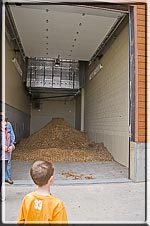

The boiler room at Glacier High School. Larger image.

Wood fuel is stored in this room next to the boiler room. Larger image.
It’s not a scandal, but it is an embarrassment: Glacier High School, my sources tell me, was built with the wrong equipment for burning the hogged wood chips that were intended as the school’s primary heating fuel (the backup fuel is natural gas).
It appears that school district officials have known for some time that something was wrong with the new “biomass” heating system. More natural gas and less hogged wood was being burned than expected. At first, I’m sure, the problem was thought to be an out of adjustment control system — probably malfunctioning sensors and buggy software — and that a technical fix existed. That’s a reasonable assumption, for all new systems need adjustments to reach optimum efficiency.
But as problems, some requiring the summoning of the fire department, continued, it became clear that the machinery installed was not designed for handling hogged wood. It was not the machinery mandated by the trustees. Why that blunder occurred needs to be explained to the public.
Tonight, we may learn how much that blunder will cost. The trustees of School District 5, who convene tonight at 1800 in the media center at the middle school (junior high school) in northwest Kalispell, have scheduled a presentation on the situation. Residents of the district should pay attention. The fix is likely to be expensive.
Update. This market assessment by CTA Architects & Engineers (PDF) of biomass boilers mentions the one at Glacier High School. And this document, Fuels for Schools, a Business Outlook (PDF), explains the program behind the push to put biomass boilers in schools.
Just how energy efficient is Kalispell’s new Glacier High School? I first asked that question last May during a tour of the almost completed building. About twice as efficient as Flathead High School on an energy per square foot basis, a representative of the firm that installed the heating plant told me. He didn’t have the numbers that I sought at his fingertips, and my tour group seemed a bit dazed by my question, so I neither pressed my inquiry nor lost interest in the matter.
The school district’s website contained nothing useful on energy efficiency that I could find. Other websites, however, yielded some basic statistics. Glacier High measures 220,000 square feet. When the heating system is operating as designed, it will burn 2,000 tons of green wood chips (40 percent moisture) during an average year. That works out to approximately 10 BTUs (one BTU raises one pound of water one degree Fahrenheit) per square foot per heating degree day. By comparison, my not that well insulated, 35-year-old house uses seven BTUs per square foot per degree day (Kalispell averages 8,100 degree days per year).
I don’t know how that compares to other new schools, or to energy efficiency standards for new schools, but it sure doesn’t compare favorably to older residential construction. I’ve been concerned from the gitgo that Glacier High’s design might have maximized space at the expense of energy efficiency, and these back-of-the envelope calculations do nothing to allay my concerns.
Oil now sells for more than $100 per barrel. The era of cheap oil — and cheap energy — is over. If Glacier High skimped on insulation, that decision will cost far more in the long run than the boiler blunder.